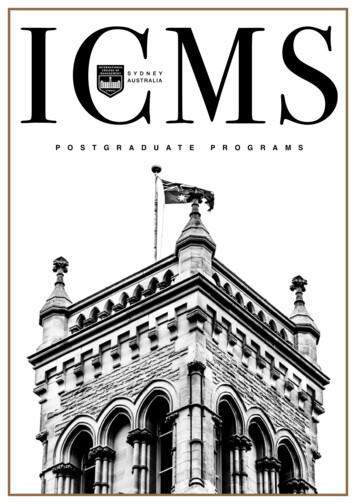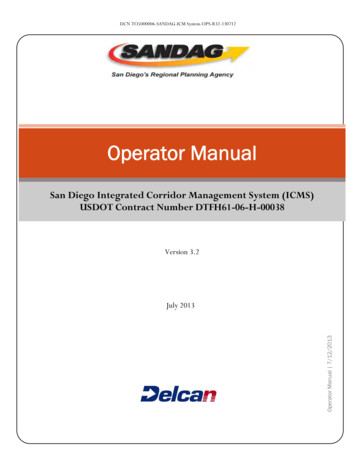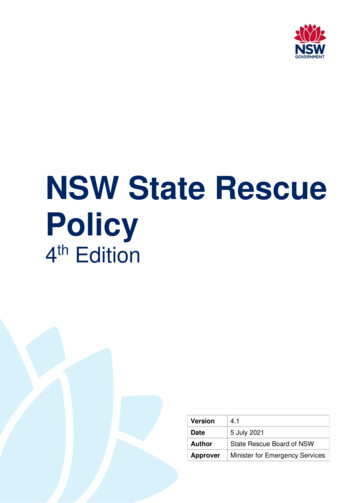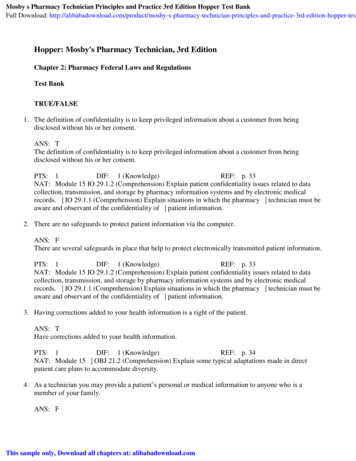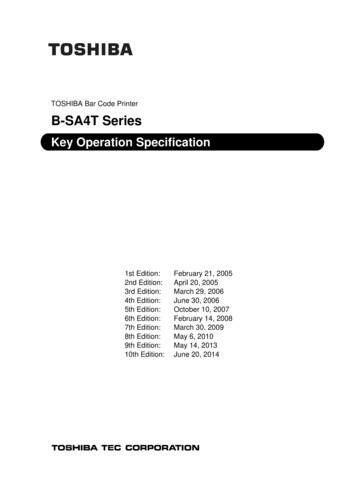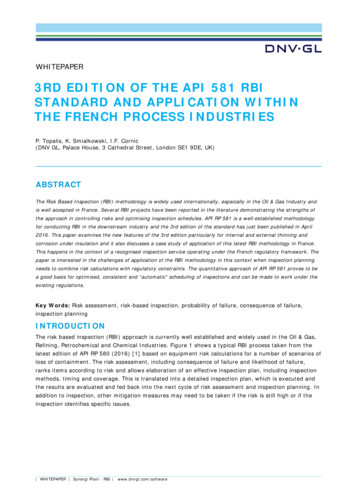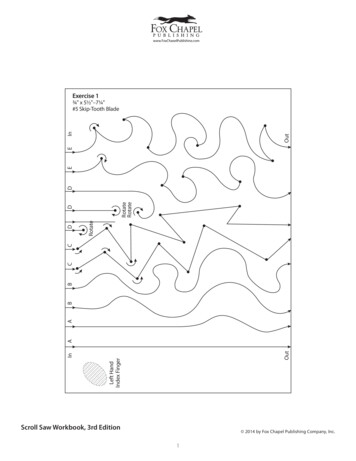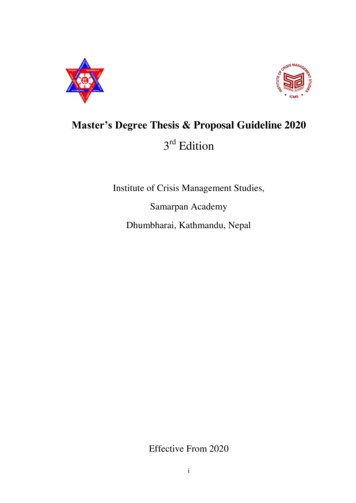
Transcription
Master’s Degree Thesis & Proposal Guideline 20203rd EditionInstitute of Crisis Management Studies,Samarpan AcademyDhumbharai, Kathmandu, NepalEffective From 2020i
About this documentThis document is the 3rd edition of Master‟s Degree thesis & Proposal Guideline forstudent of Master‟s in Crisis Management and Counselling Psychology of SamarpanAcademy. This document has been prepared upon the two edition prepared beforethis document and after review of UGS 5th edition guideline, Faculty of Humanitiesand Social Science and American Psychological Association. The document is aliving document and needs to be updated as new progresses are made in the field ofresearch. The guideline for Thesis and Thesis proposal mentioned in this documentare strictly to be followed by the student. The Thesis should not be about collection ofpages but rather be driven by content with guidelines to be followed recommended inthis document. This document has been approved by the thesis committee and will beupdated with advancement of research. The guideline is as of effective from 2020.Approved by .Dr. Ram Thapaliya (Ph.D)Thesis Committee ChairmanChair, ICMSii
Table of ContentsAbout this document .iiABREVIATION . vList of Tables . viList of Figures. viCHAPTER I: INTRODUCTION11.1 Thesis and Proposal Guidelines . 11.3 Thesis . 21.4 Thesis Topic . 21.5 Thesis Committee Approval . 31.6 Student Responsibility . 51.6 Style . 5CHAPTER II RESEARCH ETHICS92.1 Research Ethics . 9CHAPTER III: PROPOSAL REQUIREMENT113.1 Requirement of Proposal Writing . 113.2 Selecting a Topic and Formulating the Research Question . 12CHAPTER IV THESIS REQUIREMENT174.1 Master‟s Thesis . 174.2 Requirement for master thesis . 173.3Content of Thesis . 20iii
PREFATORY SECTION . 20A.Abstract . 20B.Table of Contents . 21C.List of Tables and Figures. 21D.List of Abbreviations, Acronyms and Symbols . 22E.Body of the report section . 22Chapter I Introduction . 22F.Background of the study . 22G.Problem statement . 22H.Research Question . 23I.Objectives of the study. 23J.Hypotheses (if any) . 24K.Rationale of the study . 24Chapter II Literature Review (LR). 25Chapter III Research Methodology . 26Chapter IV Findings of the study/Results . 29Chapter V Summary and Conclusion. 30L.Discussion . 30M.Summary . 31N.Limitation of the study . 31O.Conclusion . 31P.Implications. 32Q.Recommendations . 32R.Supplementary section . 32S.References . 32Appendix A: Format of preliminary materials . 34Appendix B: Table of Content . 39Appendix C: Guidelines on tables and figures . 42iv
ABREVIATIONAPAAmerican Psychological AssociationFoHSSFaculty of Humanities and Social ScienceICMSInstitute of Crisis Management StudiesLRLiterature ReviewRQResearch QuestionTUTribhuvan Universityv
List of TablesTable 1 Socio demographic of the study participant41List of FiguresFigure 1 Shows population distribution of Bidhur Municipalityvi42
CHAPTER IINTRODUCTION1.1 Thesis and Proposal GuidelinesThese thesis guidelines have been created as a guide to help Master‟s levelstudents of Institute of Crisis Management Studies (ICMS) and Master‟s incounselling psychology of ICMS, Samarpan academy to establish minimumrequirements, academic standards, the physical format and appearance of thesis. Thepurpose is to provide academic requirements and structural guidelines required forthesis writing to the students under the Faculty of Humanities and Social Science(FoHSS), Tribhuvan University (TU). The FoHSS encourages the preparation ofdocuments to be consistent with the specialized requirements prior to the submission.Submission of this document is the final step in a program leading to conferral of aMaster‟s degree.This guideline has been prepared on the basis guidelines prescribed by FoHSS, TUUGS 5th Edition and APA referencing style1.2 ProposalProposal is the first stage the student needs to go through to complete theirthesis. A thesis proposal is a document that outlines thesis topic, defines the issuesthat the thesis will address, and explains why the topic warrants further research. Itshould identify a problem and provide a solution to that problem.A thesis proposal will at least have 3 chapters, 1) Introduction, 2) Literature review,3) Methodology, Advice on the range of suitable topics which relate to the subject1
area of your Master‟s degree will be approved by the thesis supervisor and researchcommittee.1.3 ThesisA thesis is a formal academic document following the rules that govern theway in which it is presented. The thesis is the continuation of thesis proposal and willhave additional two more chapters or more depending on the research. It must have atleast 5 chapters, 1) Introduction, 2) Literature review, 3) Methodology, 4) findings ofthe study/results and 5) discussion, conclusion, recommendation. Advice on the rangeof suitable topics which relate to the subject area of your Master‟s degree will beapproved by the thesis supervisor and research committee.The thesis is the final stage of the Master‟s degree and provides you with theopportunity to show that you have gained the necessary skills and knowledge in orderto organize and conduct a research study. The thesis will show that the student havedemonstrated skills in indentifying an area, or areas, suitable for research, settingresearch objectives; locating, organizing and critically analyzing the relevantsecondary and primary data, developing an appropriate research methodology;analyzing the primary data selected and drawing on the literature in the field; drawingconclusions; and if appropriate making relevant recommendations and indications ofareas for further research.1.4 Thesis TopicStudents are responsible for selecting and developing a thesis and proposaltopic which has departmental approval.2
Firstly, the topic should be a question that falls within the scope of the discipline. Thatis to say, it should relate to the field of Crisis Management studies and for student ofcounselling psychology related to the field of counselling psychology.Second, the topic should relate to a specific area of study for which a qualifiedsupervisor is available.Third, the topic and thesis should make an original contribution to the field of CrisisManagement or Disasters Management or counselling psychology studies. This maybe done through wholly original research, or by adding to or elaborating on existingresearch, filling a gap in existing research, using existing data in a new way, drawingdifferent conclusions from existing case studies, testing existing theories and analysesthrough new case studies, and so on.The topic should be something that intrigues student. Student will spend a great dealof time reading and writing about this topic, so choose something you will enjoy andwant to explore and know more about. The topic must be one in which you will beable to conduct significant research. There must be either enough written materialavailable to analyze your topic thoroughly, or you must have access to primarysources. Primary sources could be either documents, or individuals who can beinterviewed, or a combination of both. Lastly, the topic must be manageable. Youshould be able to explore it in depth. At the same time, it should not be so broad thatyou cannot adequately answer your research question or defend your statement.1.5 Thesis Committee ApprovalThesis is an academically admirable professional document and should meetacademic vigour and professional standard in content and appearances. After thethesis content writing has been completed, the thesis should be read and approved in3
its completed version by the adviser, who will then distribute copies to two readers.Enough time must be allowed by the student for a careful reading by his/her adviserand the two readers prior to the scheduling of the thesis defense.The defense will consist of a 15-minute presentation of the thesis by the studentfollowed by each member of the committee asking questions, in turn, for up to 15minutes. Immediately following the oral defense, the committee will convene to voteon the acceptability of the thesis. The committee will make one of threerecommendations:1) The thesis passes as submitted, or with minor revisions.2) The thesis passes conditionally, but the student is required to make significantrevisions.3) The thesis fails.Recommendation 1If the thesis passes under recommendation 1, the student makes any neededcorrections (usually editorial or stylistic) and then gives the final product to theadviser who in turn submits it to the centre.Recommendation 2If the thesis passes under recommendation 2, the student must work with the adviser,and either or both of the readers, to satisfy the changes demanded by the committee.The adviser will not sign off on the thesis until such changes are completed.Recommendation 3If the thesis is not accepted, the student may rewrite it, but it will have to go through anew thesis defense.4
After the successful defense of the thesis, the student must submit three copyof revised thesis to 1) One copy to the ICMS, Samarpan Academy and 2) Two copiesto Tribhuvan University.Similarly the student must also submit thesis proposal in front of thecommittee, the committee will advice on the proposal submitted and assignappropriate thesis supervisor for the student. The thesis proposal defence is the firststage for student in completing the master‟s degree. The student must work on thecomment and suggestion provided during the thesis proposal defense by the thesiscommittee1.6 Student ResponsibilityIt is the students‟ responsibility to read and fulfil the requirements presentedhere and to submit the thesis and proposal maintaining the quality. Correct grammar,punctuation, and spelling always should be used, and these aspects are theresponsibility of the student. Please consult your supervisor and committee chair forspecific content requirements. Proofreading is the responsibility of the student andhis/her supervisor.1.6 StyleThe thesis and thesis proposal must follow the guideline prescribed in thisdocument and follow APA referencing 6th edition. The format of the documentincludes content of the prefatory pages, the type font, margins and spacing, theplacement of the page numbers, and the requirements for permission to reproducecopyrighted material.5
The details of Formatting the Thesis and Thesis proposal has been provided below.Spacing: Double spacing, except for quotations and footnotesSingle page: Type only on one side of the pageMargins: 1.5 inch left margin and 1 inch margins on all three sidesPaper Size: The dissertation should be typed on ISO A4-size white bond paper. Ifdiagrams, maps, tables and similar presentations do not fit readily on this sheetsize, ISO B4 size may be used.Font size: Size 12 fonts should be used throughout. Headings and sub-headings canbe made bold.Font Style: Times New RomanAlign Text: Justify, Body Text, Chapter heading must be kept “Centre”, all subheadings must use “Align text left”Reference style: APA, 6th EditionPage break: Each item in the front matter, back matter and all the chapters shouldstart on a new page.Pagination: Every page in the thesis has a number. For front matter section, use smallroman numerals (i, ii, iii, ). For the main text and back matter use Arabicnumber (1,2,3, ). There will be no page number of cover page. Place thenumber at the lower center of the page.Figures and tables: Tables and figures must be numbered continuously throughoutthe proposal (1.1, 1.2, 1.3) and they must be placed as close as possible to theirfirst mention in the main text. The heading of the table should be placed at thetop of the table while the caption of the figure should be at the bottom of thefigure.6
Footnote: Footnote can be used to provide supplementary information. Referencingshould not be kept at the footnote.Diction: Words should be chosen to suit the study. The diction in research papershould be formal rather than colloquial. Each words should convey themeaning as exactly as possible. Slangs and words of everyday conversationare rarely used in the research text. In the case of specialized words andjargons, definitions should be given.Verb Tense: Researchers are suggested to use of past tense to express an action or acondition that occurred at a specific, definite time in the past, but they shoulduse the present or present perfect tense (argues, has argued ) to introducesource material unless they include a date that specifies the time of the originalauthor's writing.Citing the works of others: All ideas, facts, intellectual construction, and materialused from other authors and sources must be fully acknowledged in the text.Charge of plagiarism will result in disciplinary action. The word Referencesshould appear centred at the top of the page. The first line of each entry shouldalign with the left margin. All subsequent lines should be indented 5 spaces orset a hanging indent at 1/2 inch.Students are advised to familiarize themselves with APA (AmericanPsychological Association) 6th edition second printing of the APA manual.Indent: first line of every paragraph (0.5‟‟), except for the Abstract must be done.Indent the first line of each paragraph of text 0.5 in. from the left margin. Usethe tab key or the automatic paragraph-formatting function of your word7
processing program to achieve the indentation (the default setting is likelyalready 0.5 in.). Do not use the space bar to create indentation.8
CHAPTER IIRESEARCH ETHICS2.1 Research EthicsEthical issues have come in forefront in the research writing. All students havea responsibility to conduct and report the results of their research in ethical manner.The thesis and thesis proposal represents the culmination of years of academicpreparation and expresses a student‟s ideas, training and skills. The thesis thereforedeserves the student‟s effort and with all scholarly work, demands obedience withhighest ethical standards. Fabrication, falsification and plagiarism in proposing,conducting or reporting research or other scholarly activities are ethical misconduct inresearch. Fabrication means making up results and falsifying research results refers toaltering, misrepresenting, or selective misquoting of the findings. Each of theseactivities violates the integrity of the research process and constitutes a serious breachof accepted ethical standards. Ethical research practice therefore requires that studentsat all stages of the research process conduct their research in honest manner and makeevery effort to ensure the accuracy of their findings. Plagiarism is a form of ethicalmisconduct in research and consists of the intentional or unintentional use of thewords, ideas, diagrams of publicly available work without appropriatelyacknowledging the sources of these materials. Thus, any use of the words, phrases,ideas, or work of others in any form without acknowledgement of the original sourcesconstitutes plagiarism and is subject to penalty. Students must be aware toacknowledge the contents of literature review, the ordering of ideas in the discussion,and the listing of references at the end of a discussion, which may reflect the thinking9
of others. These contributions must be acknowledged and cited. Therefore, theresearchers are advised to be conscious on ethical issues particularly in the following:Data retention and sharing: It is the duty of the researcher to retain and share thedata used in the study. The researcher must produce every bit of data to the supervisorwhile working on the research. The researcher must keep them ready at the time ofviva voce and produce as evidence on demand.Plagiarism: Plagiarism is, as stated earlier, claiming others‟ words and ideas as yourown. It is strictly prohibited. The researcher must take permission for all copyrightmaterials. S/he can refer other researchers‟ writings in her/his dissertation, but thecredit to the source must be given in the text and list in the list of references. Thestudent must use APA reference style and cite the document in text and with aseparate reference list. The Student must at least maintain 80-85% originality.Protecting confidentiality: During the research, the researcher may have access toconfidential information of a person or an institution. It is the duty of the researcher tomaintain the confidentiality of the person or the institution. A student must takewritten or oral consent from the respondent during the study. The consent form mustbe attached in the Annex of the document.10
CHAPTER IIIPROPOSAL REUQIREMENT3.1 Requirement of Proposal WritingThe thesis proposal describes what the researcher intends to do and how it will bedone. It should outline in clear terms the nature and intent of the research. Theproposal works as a road map in the journey of research. Students must submit athesis proposal to the ICMS, Samarpan Academy for review. Once approved, thestudent will have to prepare the report as outlined in the proposal. In the process ofwriting a proposal, the first step is to identify the possible area of the study. In thesecond step, students should do the preliminary review of literature in the chosen areaof the study and raise some issues for investigation. In the next step, it is important toexamine whether data will be available on the chosen topic or not. Finally, it is wiseto evaluate possible obstacles (e. g. the study will take too long time to complete, orrequires long-distance travel, or involves health hazard, etc.) in carrying out researchon the chosen area. If everything goes fine to this point, the researcher can finalize thetitle for the research work. The title of the thesis should reflect the main idea of theresearch work. The title should be concise but should incorporate significant variablesin the study and their relationship. An example of good title is “Community supportduring disasters- a review of man-made disasters in the Bajura District and theirmanagement.” Or “Psychological needs assessment of caregivers in disastersituations- review of literature.”Always avoid using abbreviations and verbose terms(e. g. “A Study of , An Investigation into , An Understanding of ” in the title.It is generally suggested to limit the length of the title within 12 words. The11
approximate length of the proposal is 20-25 pages, double spaced. An acceptablethesis proposal contains the following elements:i.Cover pageii.Overview clearly stating thesis question and hypothesis (1 page)iii.Title page with space for committee members‟ approvalsiv.Introduction: Research problem, context, justification of thesis (4-6 pages)v.Literature review (5-7 pages)vi.Methodology (2-3 pages)vii.Objectives and research questions to be answered (1-2 pages)viii.Materials (2-3 pages)ix.Limitations and ethical issuesx.Work plan, procedure and outline (2 pages)xi.Appendix (if any)The following are guidelines for preparing the proposal, with suggestions on how tobegin and what the committee looks for when they review proposals.3.2 Selecting a Topic and Formulating the Research QuestionYou should read as widely and specifically as is required to determine what has beenwritten on your chosen topic and what contribution you might make. As you read, youshould think about the following: What question or questions will the thesis address? Why do these questions matter? What answer or answers will the thesis offer to these questions? What contribution will the answers make to our knowledge about crisis/DRR?12
What kinds of materials and what sort of analysis will be needed to answer thequestions raised?You need to develop a strong background on the topic and become thoroughlyfamiliar with the research and writing that others have done.3.3 Research Questions and HypothesesTake your objectives and make them into questions; then state the answers to yourquestions in terms of what you expect to find. These are your hypotheses. It isimportant to realize that you come to the thesis with a preconceived idea about theanswers you will find.3.4 Research ProblemThe most important part of any research proposal is the question or problem to beanalyzed. All else in the proposal (and your research) derives from that. Therefore, itis essential that the research problem is formulated carefully.3.5 LiteratureThe proposal should also contain a summary of what was discovered during thesearch of the literature in order to develop your research problem. Here is where youcategorize what others have written on the same or similar subjects. The presentationof the literature about your topic in the proposal should be selective, organized andsummarized.3.6 Methodology13
The methodology of your thesis is how you intend to address the questions that yourresearch problem raises. It is your intellectual approach or strategy for answering thequestions raised. In this section of the proposal, you will explain your orientation tothe subject you intend to investigate and specify the theory or conceptual frameworkyou will use in selecting your material and analyzing it.3.7 ObjectivesThe objectives of your proposal are a specification of the things which you mustaccomplish in order to produce a comprehensive solution to the research problem.They are a restatement of your research problem in specific terms, indicating a seriesof interconnected results. They are part of your research strategy and should relate toyour methodology.3.8 MaterialsThe materials section of your proposal is a discussion of the sources you will use inresearching the problem and deriving answers to the questions and hypotheses youhave developed. Where are you going to look and what are you going to look for andanalyze in order to find answers to the questions you have raised?3.9 Work Plan, Procedure and OutlineYou should specify a plan of work. This means you should categorize the materialyou intend to use in terms of how and when you will collect each part of it, what youwill be looking for in analyzing it, and how you will organize your time. Your workplan should include a tentative outline for writing the thesis. The outline should be14
detailed and attempt to reflect your procedure in addressing the research problem andthe questions and hypotheses which you have derived from it.3.9 Proposal StructurePREFATORY SECTION: This section is organized in the following orderRESEARCH TITLE (Specific and clear)ABBEVIATION/ ACRONYMSTABLE OF CONTENTSLIST OF FIGURESABSTRACT (Summarizes project well)Chapter I Introduction1.1 Background of the study1.2 Background of the study (Adequate, relevant, well stated)1.3 Problem Statement (Adequate, relevant, well stated)1.4 Rational / Significance of the study1.5 Research questions1.6 Research Objectives (Academically interesting, adequate, achievable)1.7 Conjectures/Hypotheses (Optional)1.8 Theoretical /Conceptual Framework (To be well framed )1.9 Operational definitionChapter II Literature Review2.1 Literature Review2.2 Research Gaps (Adequate, relevant and gaps identified)2.3 Summary of reviewed literaturesChapter III Research Methodology(Study Design, Methods, Tools and Data analysis (Faultless, advanced, well suitedand skilful, Five traditions school of Qualitative Research, Creswell, Social Statistics15
for a diverse society 3rd edition Chava Frankfort-Nachmias & Anna Leon-Guerrero,Statistics 5th Edition, Joseph F. Healey) As recommended or required book or coursematerial used in the class and prescribed in the course curriculum. Also refer to “TheUGC Research Development and Innovation Programs Implementation Guideline”,2019 5th Edition Guideline, September 2019.3.1 Study Design (including Theoretical perspective)3.2 Study Setting3.3 Study population and Study sample3.4 Sampling frame and sampling technique3.5 Sample size3.6. Study variables3.7 Instrumentation/ data collection tool3.8 Data collection procedure3.9 Data Analysis plan and procedure3.10 Delimitation of the study3.11 Ethical consideration (Ethical and Safety Issues well addressed)3.12 Gantt Chart and budget (Well planned, actual)REFERENCESAPPENDICESPlease check chapter III of this guideline for additional information16
CHAPTER IVTHESIS REQUIREMENT4.1 Master’s ThesisA master‟s thesis is a substantial document presenting independent researchthat makes a contribution to the current body of knowledge in a scholarly field. Theauthor may conduct an original investigation or develop an original interpretation ofexisting research and/or literature. A thesis adheres to a standard format, generallywith several basic chapters that may include an introduction and statement of theproblem, a review of the literature pertinent to the problem, an explanation of thematerials and methods used to solve the problem, a results section, a discussion of theresults, and a conclusion. A formal list of references cited in the dissertation also isrequired. The thesis and thesis proposal must be formatted to conform to thespecifications as stated in this Guideline. The detail has been presented below4.2 Requirement for master thesisThe thesis must be written in English, typed and double-spaced. It will bejudged on content, organization, documentation and presentation. With regard tolength, ICMS requires that a thesis is between 20,000 and 25,000 words (not inclusiveof footnotes, abstract, outlines, annexes, appendices, references, etc.). The Structureof the thesis follows the structure of proposal till chapter III. In addition the thesis willhave additional two more chapters. The structure of the thesis has been presentedbelow. (Please note research proposal will only be till chapter 3)17
PREFATORY SECTION: This section is organized in the following orderRESEARCH TITLE (Specific and clear)DEDICATIONACKNOWLEDGMENTABBEVIATION/ ACRONYMSTABLE OF CONTE
ii About this document This document is the 3rd edition of Master‟s Degree thesis & Proposal Guideline for student of Master‟s in Crisis Management and Counselling Psychology of Samarpan Academy. This document has been prepared upon the two edition prepared before
